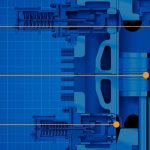Learn about the techniques of controlling NOx emissions in modern day ships and what companies are doing to ensure that pollution to the environment due to NOx is reduced.
Methods for Controlling Shipboard Nitrous Oxide Emissions
Emissions by marine vessels are also known as Marine NOx (marine nitrous oxides). These emissions can be harmful for human health and the environment; they are also a major source of atmospheric pollution.
In recent years, there has been an influx in the reduction of emissions from industry and road vehicles and the IMO imposed stringent restrictions on marine NOx emissions in 2008 by introducing reduced NOx requirements worldwide for all new ships.

A study conducted by the Swedish environmental economist identified three technologies that could be used to reduce emissions:
○ (SCR),
○ Humid Air Motor,
○ Engines Fuelled by Liquefied Natural Gas (LNG)
○ Selective Catalytic reduction
This is a system developed to reduce NOx using an additional agent that converts NOx to harmless gases.
How SCR works- the SCR system has four major components: a Diesel exhaust fluid tank (DEF), a DEF doser, the SCR catalyst and an ammonia catalyst. The four above components are all integrated in the exhaust system were small amounts of DEF are infected in a catalyst were it mixes and reacts with the NOx found within the exhaust to make nitrogen gas and water vapor. Both of the products are than released since they are harmless to the atmosphere.
Benefits of SCR- besides being good for the environment, SCR technology improves fuel economy and increases engine reliability. Engines with SCR will run cooler, burn fuel cleaner and be more fuel-efficient.

Does SCR work- the technology has been tested for several years and has been proven effective in some of the world’s harshest conditions; over half a million vehicles were performing with SCR technology by 2010.
DEF- this is a solution of purified water and Urea mixed in the following proportions respectfully 67% to 33%. The solution is non-toxic and urea is a natural component that is produced from natural gas.
DEF usage- its usage proportion is substantially less than the fuel, it is estimated 2/100 would be the ratio of use thus meaning you will use 1 gallon DEF for 50 gallons of diesel fuel.
2. Humid Air Motor
This is another technology used to reduce NOx produced by diesel engines. It reduces up to 65% of NOx formation in engines.
How HAM works- the quantity of NOx formation depends on the temperature in and around the combustion chambers. Higher temperatures mean more NOx production where as lower temperature means the less NOx production. The technology is developed to inject heated water in to the compressed combustion air to keep the temperature cooler. The quantity of the water injected for NOx reduction varies differently with the temperature of the engine. The following steps simplify how HAM works:
○ Filtered saltwater is pumped to the tank to used water.
○ The system circulates the water from tank to HAM and back.
○ During circulation a heat source on engine heats the water in Ham and tank.
○ Water injected for NOx spraying is heated saltwater which is mist sprayed in to the charged air.
○ The charged air passes through the HAM vessel were small particles like salt from water are caught in catchment and humidified cool air is sent to the engine.
○ The air then passes through a mist catcher to collect any tiny water droplets that have not vaporized.
○ The saturated air is than fed in to the engine.
3. Engines Fuelled by Liquefied Natural Gas
Norway began using the technology over a decade age. It is practice and cost effective over the long-term basis. The only major cost that is incurred is the purchase and installation of the LNG storage tanks and piping. This is also not a major problem since the saving fuel costs are considerably high. Vessels are said to save up to 1 million dollars a year on fuel costs. The emissions are also reduced by a staggering 80% making it one of the cleanest fuels that can be used to produce energy.
This was found to be the best method of reducing emissions by the study that was conducted by the Swedish researcher but no restriction has been imposed on the type of emissions control mechanism that should be used on board marine vessels.
There have been other proposals that have been suggested for the reduction of marine NOx emissions, but they don’t seem to have produced satisfactory results. For example water injection for Nox reduction is said to reduce Nox by roughly 25% but obviously produces corrossion problems.
With the ever-growing concerns about the effects of human activity on global warming, only the most effective methods can be considered. The future may bring new ideas and methods that may reduce or reverse the effect of marine NOx emissions on the atmosphere. As of now, these are some of the best methods that can be put in place to curb marine NOx quantities.


